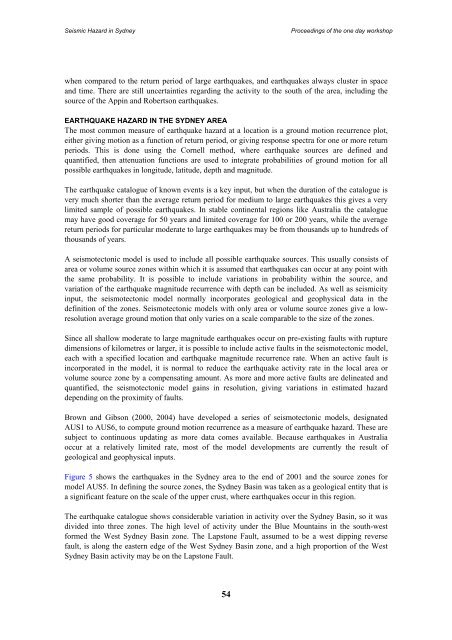Landslides in the Sydney Basin - Geoscience Australia
Landslides in the Sydney Basin - Geoscience Australia
Landslides in the Sydney Basin - Geoscience Australia
- No tags were found...
You also want an ePaper? Increase the reach of your titles
YUMPU automatically turns print PDFs into web optimized ePapers that Google loves.
Seismic Hazard <strong>in</strong> <strong>Sydney</strong>Proceed<strong>in</strong>gs of <strong>the</strong> one day workshopwhen compared to <strong>the</strong> return period of large earthquakes, and earthquakes always cluster <strong>in</strong> spaceand time. There are still uncerta<strong>in</strong>ties regard<strong>in</strong>g <strong>the</strong> activity to <strong>the</strong> south of <strong>the</strong> area, <strong>in</strong>clud<strong>in</strong>g <strong>the</strong>source of <strong>the</strong> App<strong>in</strong> and Robertson earthquakes.EARTHQUAKE HAZARD IN THE SYDNEY AREAThe most common measure of earthquake hazard at a location is a ground motion recurrence plot,ei<strong>the</strong>r giv<strong>in</strong>g motion as a function of return period, or giv<strong>in</strong>g response spectra for one or more returnperiods. This is done us<strong>in</strong>g <strong>the</strong> Cornell method, where earthquake sources are def<strong>in</strong>ed andquantified, <strong>the</strong>n attenuation functions are used to <strong>in</strong>tegrate probabilities of ground motion for allpossible earthquakes <strong>in</strong> longitude, latitude, depth and magnitude.The earthquake catalogue of known events is a key <strong>in</strong>put, but when <strong>the</strong> duration of <strong>the</strong> catalogue isvery much shorter than <strong>the</strong> average return period for medium to large earthquakes this gives a verylimited sample of possible earthquakes. In stable cont<strong>in</strong>ental regions like <strong>Australia</strong> <strong>the</strong> cataloguemay have good coverage for 50 years and limited coverage for 100 or 200 years, while <strong>the</strong> averagereturn periods for particular moderate to large earthquakes may be from thousands up to hundreds ofthousands of years.A seismotectonic model is used to <strong>in</strong>clude all possible earthquake sources. This usually consists ofarea or volume source zones with<strong>in</strong> which it is assumed that earthquakes can occur at any po<strong>in</strong>t with<strong>the</strong> same probability. It is possible to <strong>in</strong>clude variations <strong>in</strong> probability with<strong>in</strong> <strong>the</strong> source, andvariation of <strong>the</strong> earthquake magnitude recurrence with depth can be <strong>in</strong>cluded. As well as seismicity<strong>in</strong>put, <strong>the</strong> seismotectonic model normally <strong>in</strong>corporates geological and geophysical data <strong>in</strong> <strong>the</strong>def<strong>in</strong>ition of <strong>the</strong> zones. Seismotectonic models with only area or volume source zones give a lowresolutionaverage ground motion that only varies on a scale comparable to <strong>the</strong> size of <strong>the</strong> zones.S<strong>in</strong>ce all shallow moderate to large magnitude earthquakes occur on pre-exist<strong>in</strong>g faults with rupturedimensions of kilometres or larger, it is possible to <strong>in</strong>clude active faults <strong>in</strong> <strong>the</strong> seismotectonic model,each with a specified location and earthquake magnitude recurrence rate. When an active fault is<strong>in</strong>corporated <strong>in</strong> <strong>the</strong> model, it is normal to reduce <strong>the</strong> earthquake activity rate <strong>in</strong> <strong>the</strong> local area orvolume source zone by a compensat<strong>in</strong>g amount. As more and more active faults are del<strong>in</strong>eated andquantified, <strong>the</strong> seismotectonic model ga<strong>in</strong>s <strong>in</strong> resolution, giv<strong>in</strong>g variations <strong>in</strong> estimated hazarddepend<strong>in</strong>g on <strong>the</strong> proximity of faults.Brown and Gibson (2000, 2004) have developed a series of seismotectonic models, designatedAUS1 to AUS6, to compute ground motion recurrence as a measure of earthquake hazard. These aresubject to cont<strong>in</strong>uous updat<strong>in</strong>g as more data comes available. Because earthquakes <strong>in</strong> <strong>Australia</strong>occur at a relatively limited rate, most of <strong>the</strong> model developments are currently <strong>the</strong> result ofgeological and geophysical <strong>in</strong>puts.Figure 5 shows <strong>the</strong> earthquakes <strong>in</strong> <strong>the</strong> <strong>Sydney</strong> area to <strong>the</strong> end of 2001 and <strong>the</strong> source zones formodel AUS5. In def<strong>in</strong><strong>in</strong>g <strong>the</strong> source zones, <strong>the</strong> <strong>Sydney</strong> Bas<strong>in</strong> was taken as a geological entity that isa significant feature on <strong>the</strong> scale of <strong>the</strong> upper crust, where earthquakes occur <strong>in</strong> this region.The earthquake catalogue shows considerable variation <strong>in</strong> activity over <strong>the</strong> <strong>Sydney</strong> Bas<strong>in</strong>, so it wasdivided <strong>in</strong>to three zones. The high level of activity under <strong>the</strong> Blue Mounta<strong>in</strong>s <strong>in</strong> <strong>the</strong> south-westformed <strong>the</strong> West <strong>Sydney</strong> Bas<strong>in</strong> zone. The Lapstone Fault, assumed to be a west dipp<strong>in</strong>g reversefault, is along <strong>the</strong> eastern edge of <strong>the</strong> West <strong>Sydney</strong> Bas<strong>in</strong> zone, and a high proportion of <strong>the</strong> West<strong>Sydney</strong> Bas<strong>in</strong> activity may be on <strong>the</strong> Lapstone Fault.54
















